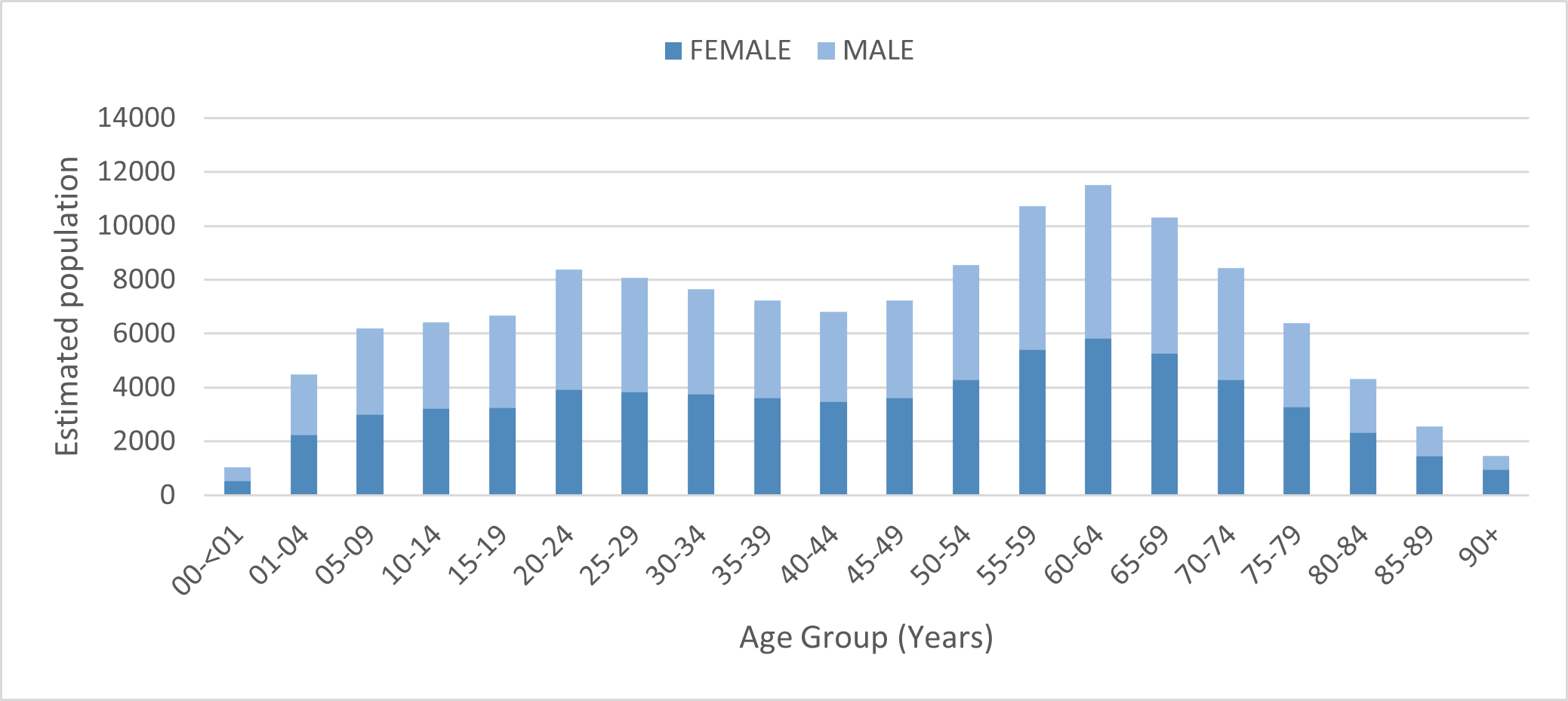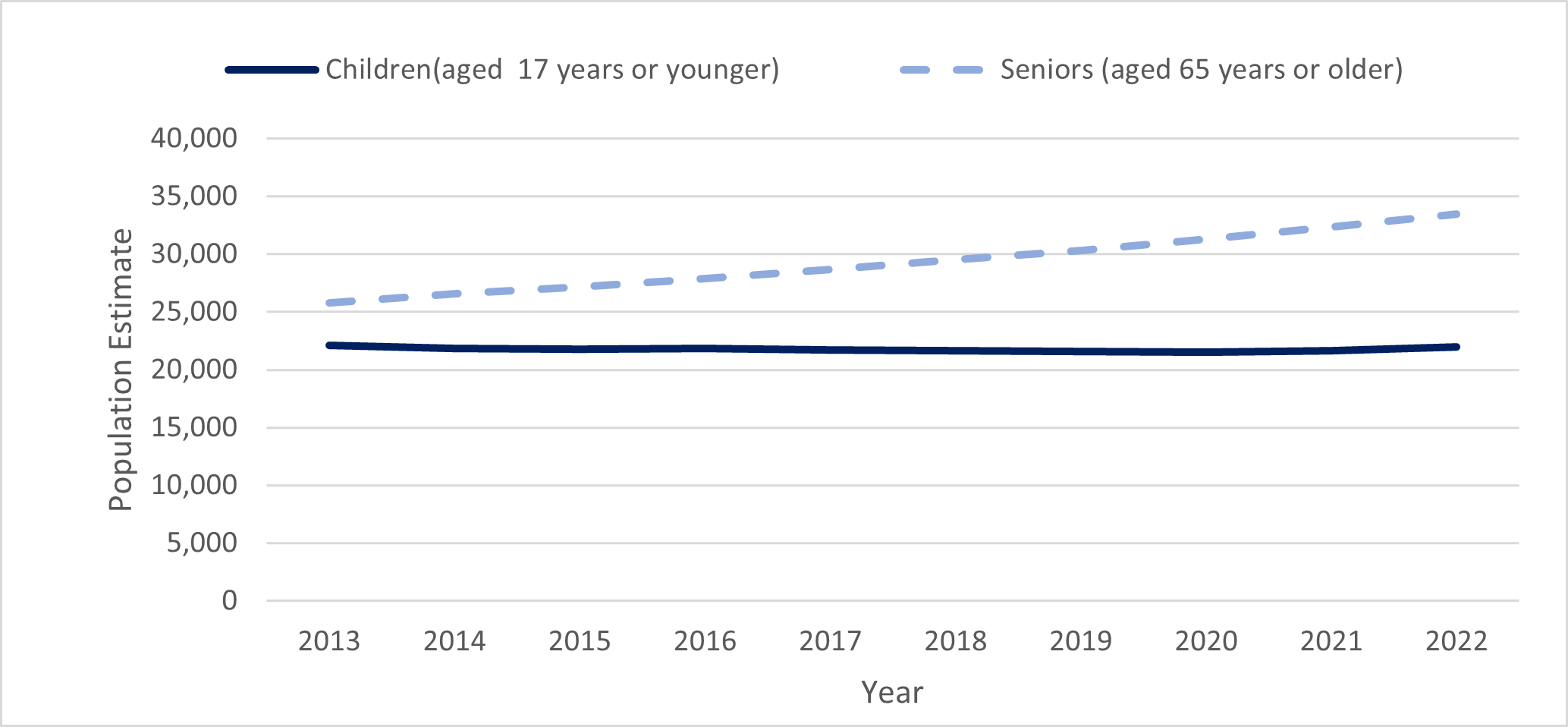Health Unit Region Population Estimates
- The 2022 population estimate for the North Bay Parry Sound District Health Unit (Health Unit) region is 134,461 individuals. Between 2013 and 2022, the regional population increased significantly by 6,832 individuals or 5.4%.
Population for Health Unit region:
- The age groups that comprised the highest percentage (nearly one-third) of our regional population were adults aged 50 to 69 years, compared to Ontario where 20 to 39 year olds were the age groups most represented in the population (see Figure 1; Table 1).
- The regional population of children aged 17 years or younger has not significantly changed between 2013 and 2022 (see Figure 2). In comparison, the population of seniors (adults aged 65 years or older) has increased significantly by about 29.6%.
- The percentage of males and females within each age group is between 48% and 52% within all age groups, respectively, with the exception of adults aged 80 years and older. Females represented 66.1% of the population aged 90 years or older, and 55.3% of the population aged 80 to 89 years (see Figure 1; Table 1).
Population for Nipissing and Parry Sound Districts:
-
In the adjusted Nipissing district, adults aged 55 to 64 years old were the most represented age groups in the population (approximately 15.1%; see Table 2). Similar proportions of age groups are present in the East Nipissing area. Conversely, adults aged 20 to 29 years were the most represented age groups in North Bay and adults aged 60 to 69 years in the West Nipissing area.
-
In the Parry Sound district, adults aged 60 to 69 years comprised the highest percentage of the population (18.8%; see Table 3). Similarly, the same age groups were the most represented in the population of the North East Parry Sound area and West Parry Sound area, compared to adults aged 55 to 64 years in the South East Parry Sound area.
-
Of the municipalities served by the Health Unit within the adjusted Nipissing district, the population increased significantly by 4032 individuals between 2013 and 2022. In the Parry Sound district, the population has increased significantly by 2800 individuals since 2013.
-
In the adjusted Nipissing district, the population of children aged 17 years or younger has decreased significantly by 2.5%, compared to 4.2% increasing significantly in the Parry Sound district between 2013 and 2022 (see Table 4).
-
The senior population (adults aged 65 years and older) has increased significantly by 27.8% in the adjusted Nipissing district and 32.2% in the Parry Sound district between 2013 and 2022 (see Table 5).
| Figure 1. Population estimates for the Health Unit region | |||||||||||||||||||||||||||||||||||||||||||||||||||||||||||||||||||||||||||||||||||||||||||||||||||||||||
|
Figure 1. 2022 Population Estimates for Individuals Residing Within the North Bay Parry Sound District Health Unit Region, by Sex and Age Group
|
|||||||||||||||||||||||||||||||||||||||||||||||||||||||||||||||||||||||||||||||||||||||||||||||||||||||||
| Figure 2. Population estimates for children and seniors within the Health Unit region | |||||||||||||||||||||||||||||||||||||||||||||||||||||||||||||||||||||||||||||||||||||||||||||||||||||||||
|
Figure 2. Population estimates for children and seniors within the Health Unit region, by year
|
|||||||||||||||||||||||||||||||||||||||||||||||||||||||||||||||||||||||||||||||||||||||||||||||||||||||||
| Table 1. Population estimates for the Health Unit region | |||||||||||||||||||||||||||||||||||||||||||||||||||||||||||||||||||||||||||||||||||||||||||||||||||||||||
|
Table 1. 2022 Population Estimates for Individuals Residing Within the North Bay Parry Sound District Health Unit Region, by Sex and Age Group
|
|||||||||||||||||||||||||||||||||||||||||||||||||||||||||||||||||||||||||||||||||||||||||||||||||||||||||
| Table 2. Population estimates for the adjusted Nipissing district | |||||||||||||||||||||||||||||||||||||||||||||||||||||||||||||||||||||||||||||||||||||||||||||||||||||||||
|
Table 2. Population Estimates for Individuals Residing Within the Adjusted Nipissing District, by Age Group and Planning Area, 2022
|
|||||||||||||||||||||||||||||||||||||||||||||||||||||||||||||||||||||||||||||||||||||||||||||||||||||||||
| Table 3. Population estimates for Parry Sound district | |||||||||||||||||||||||||||||||||||||||||||||||||||||||||||||||||||||||||||||||||||||||||||||||||||||||||
|
Table 3. Population Estimates for Individuals Residing Within the Parry Sound District, by Age Group and Planning Area, 2022
|
|||||||||||||||||||||||||||||||||||||||||||||||||||||||||||||||||||||||||||||||||||||||||||||||||||||||||
| Table 4. Population estimates for children (aged 17 years or younger) within the Health Unit region | |||||||||||||||||||||||||||||||||||||||||||||||||||||||||||||||||||||||||||||||||||||||||||||||||||||||||
|
Table 4. Population Estimates for Children (aged 17 years or younger) Within the Health Unit Region, by District and Year
|
|||||||||||||||||||||||||||||||||||||||||||||||||||||||||||||||||||||||||||||||||||||||||||||||||||||||||
| Table 5. Population estimates for seniors (aged 65 years and older) within the Health Unit area | |||||||||||||||||||||||||||||||||||||||||||||||||||||||||||||||||||||||||||||||||||||||||||||||||||||||||
|
Table 5. Population Estimates for Seniors (aged 65 years and older) Within the Health Unit Region, by District and Year
|
|||||||||||||||||||||||||||||||||||||||||||||||||||||||||||||||||||||||||||||||||||||||||||||||||||||||||
| Definitions, data sources and methodology | |||||||||||||||||||||||||||||||||||||||||||||||||||||||||||||||||||||||||||||||||||||||||||||||||||||||||
|
Definitions: Population estimates: Population counts based on census subdivision populations. Adjusted Nipissing district: Only includes municipalities served by the North Bay Parry Sound District Health Unit; excludes South Algonquin, Temagami, and Bear Island. Data sources: Statistics Canada 2022, Ontario Ministry of Health, IntelliHEALTH Ontario, Date Extracted: 2024/03/07. The original data source is the Demography Division of Statistics Canada. Methodology: Population estimates are based on the census counts adjusted for net undercoverage beginning with the 1986 census. Population estimates are final intercensal estimates that are interpolated using the adjusted census counts for the census years around the year that the estimates are for. Population estimates beyond the most recent census onwards are extrapolated by applying the growth rates by age and sex of each census division (CD) to the census subdivisons that comprise that CD. For more details on this methodology, please see: "Postcensal estimates of census subdivisions population by age and sex” (April 2015) produced by Statistics Canada. |




